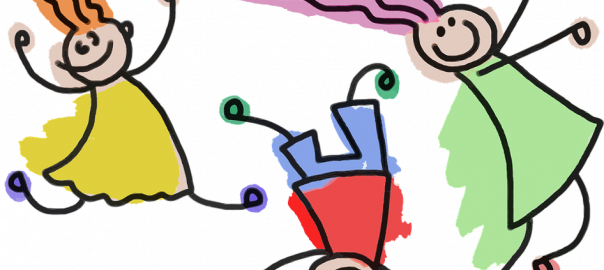
New Programs in the New Year: Children’s Yoga!
Try something NEW this New Year! I will be offering a series of children’s yoga classes for various age groups during the upcoming winter storytime break in January 2017. Check out our Children’s Event Calendar to see dates and times.
You might be asking yourself, What is yoga? What place does yoga have in the library? Why children’s yoga? Excellent questions!
What is Yoga?
Put simply, yoga is a physical and mental practice with roots in ancient India that focuses on uniting our whole selves – mind, body, and spirit. By bringing attention to our breath (spirit), doing various poses (body), and focusing on the present moment (mind), we can bring the three parts of the self into harmony, benefiting our physical and mental health. While yoga is often used as a form of exercise, that is not its sole purpose. For some, yoga is a way of life or a philosophy. And while yoga has ties to various religions, it is not inherently a religious practice. The yoga being practiced in the library has no religious element.
Why Yoga in the Library?
Allow me to refer to part of Chelmsford Public Library’s mission statement: “The Library seeks to be an integral part of its community by offering a variety of materials, services, and programs to enrich daily lives, extend personal and intellectual development, and enhance educational endeavors.”
I truly believe that bringing yoga into the library will enrich families lives, extend their personal and intellectual development, and enhance educational endeavors, especially for our children! Today’s world is complex and we are so often busy thinking about everything but the present. We can all benefit from some much needed mindfulness through yoga.
Why Children’s Yoga?
Children’s yoga classes are nothing like adult yoga classes and the format and activities vary widely depending upon the age of the children, so it’s easier to answer this question in parts:
Why yoga for babies and toddlers?
Babies and toddlers are natural yogis – they constantly live in the moment (not to mention their flexibility!). But what about their caregivers? So often in today’s complex world, our days are bursting with activity and we spend much of our time thinking about anything BUT the present moment. Rushing from one thing to the next, we often forget to take time to really focus on what we are experiencing. A baby or toddler yoga class gives caregivers an opportunity to spend time focusing on nothing but being with their child in the present moment, a truly wonderful bonding experience.
In terms of growing bodies, baby and toddler yoga both focus on developmentally supportive movements and poses. What does that mean? Children will discover and practice many of the moves we do in a yoga class on their own. By assisting them into various poses and helping with these movements, we’re preparing their little bodies for future development. For instance, baby tummy postures help strengthen the core muscles needed for crawling, while downward dog pose helps toddlers connect their upper and lower bodies, a necessary part of body integration.
Why yoga for preschoolers?
I teach preschool yoga as a yoga storytime, connecting preschoolers’ natural love of stories and movement. Traditional library storytimes help children develop school readiness skills that will prepare them for success in the classroom. These skills range from physical to social to discipline-based (language/literacy; mathematics; science; art; etc.). A yoga storytime helps children not only develop in many of these areas, but also aids in cultivating mindfulness skills. For instance, practicing various yoga poses helps children with their gross motor skills, while doing partner poses also aids in their social development.
Why yoga for school-age children?
Students today are stressed out and anxious from an early age. In an article on WebMD, University of Michigan professor Richard L. Hall, PhD, says, “Students are put in a position of feeling they just must not stop. They are not given a sense of support. They are put in an environment where they are not accepted for themselves but only for what they are going to achieve. All this builds stress” (emphasis added). Who has time for mindfulness when the focus is always on the future–on what you will know instead of what you do know; on who you will be instead of who you are? Teaching mindfulness techniques to school-age children through yoga can help them cope with this school stress and benefit their mental health in the long run.
As a Certified ChildLight Yoga instructor, one of my New Year’s resolutions is to deepen my own yoga practice through teaching others, especially children, how to slow down and enjoy the moment, accepting themselves as they are right now.
I hope to see you in my classes!
~*Nicole






